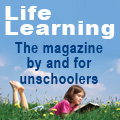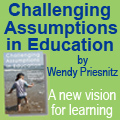|

The Intergenerational Play Project
Regaining our ability to have fun with children
by Bernie De Koven
I herewith invite you to join an imaginary social movement. I call it “The Intergenerational Play Project.” Behold, the call to action:
The Call to Action
The separation between parents and children, adolescents and family is so wide that we hardly recognize ourselves in each other. Our generations have become institutionally isolated, divided out into schools, businesses, factories, day care centers, hospitals, rest homes. Our days have become so filled with working and consuming, so consumed by “communication” that with have little time for ourselves, less time for each other, and no time for our community. The result is a steady deterioration of marriage and family, community and planet.
The Intergenerational Play Project, were there actually such a thing, would be directed towards the development of community-based experiential education programs in the art and wisdom of playing well with children – programs in intergenerational fun for people who live and/or work with children: parents, teens, teachers, recreation leaders, caregivers.
We are very poorly informed about the art of playing with children. All we have to go by is our own childhood, and the vague memories of how adults played with us. If we do not pay careful attention, we find ourselves revisiting the very same inequities on our children, and ourselves. We get caught in the game, rather than the spirit of play, and do the violence to them that was done to us.
Playing well with children is an opportunity for deep growth – for the children, yes, but even more for teens, parents, and grandparents. If we can learn to play consciously, lovingly, openly, our games can lead us to moments of profound spiritual union and rebirth. Our children become our mentors, revising our vision, increasing our compassion and our capacity for joy.
Our wholeness, as individuals, as families, neighbors, communities, nations, is dependent on a healthy and healing interdependence with our children. Playing well with children is, in truth, the only living connection we have with our childhood. As challenging as it can sometimes be, playing well with children is the best way we have to become fully adult.
Intergenerational play is remarkably beneficial, deeply healing, to our family and its extensions, to our community and its extensions. One of my favorite things to do in the world is walk through a park on an afternoon, where families actually play together. Miracles of democracy. Acres of peace.
When intergenerational play is healthy, it is miraculously healing. But it is remarkably fragile. As parents, our play is fraught with constant danger that we’ll make the baby cry or the pet bite or the forest die. We tickle too much or throw too high or drop too hard.
In our relationships to our children, in relationships between generations, between our parents and ourselves and our children and neighbors and native peoples and our planet, civilization is still not wise enough to produce the kind of parents we deserve. We still hurt each other and our world. We still forget to make the fun loving enough. We drop the baby and the ball and we poison the planet.
It’s too easy to make our children into objects of our love, to find ourselves not really playing alongside with them, but playing with them as if they were toys. Like most of the people we work for toy with us.
We need to learn how to play even more sensitively with our children, more consciously, more conscious of their enlivening presence. And I’ll definitely be writing more about that, even though I’ve already described a whole bunch of such mutually-empowering games on my website www.deepFUN.com on the games page.
I think the fault is really only in a very small part of ourselves, or in our relationships to our beautifully fun loving children. And it has ridiculously little to do with what game we’re playing with them.
It’s the times. The too many times we spend away from children. Too many times, in relationships with people who aren’t even playing, in offices and conference rooms and military camps, on airplanes and in hotel lobbies where no kids sing.
And even when we finally find ourselves actually at play with our children, rapt in some game in the name of loving and fun, we have to be reminded that they are not our toys. We have to be reminded what the game is for. We have to be reminded that in the real world, for all our fame and gain, getting to play with our children is the biggest and longest-lasting prize.
I hereby call for a demonstration. A public proclamation of our shared commitment to intergenerational play.
The Demonstration: The Festive Family Festival
When We Eat
It’s pretty much all the time. Eating is something we pretty much do from the time we get there to the time we leave.
What We Eat
Actually, we taste.
We taste, for example, peanut butter and jelly sandwiches. Teeny sandwiches, made from various combinations of any of five different kinds of bread and six different kinds of peanut butter and several more different kinds of jelly and jam, not to mention cream cheese and celery.
And for dessert, we taste perhaps S’mores. Five or four different kinds of graham cracker, nine or eight different kinds of chocolate, three or more different kinds of marshmallows. And perhaps even a random assortment of jellies and peanut butter.
Then there’s the cookies and milk, the chips and the dips, the crackers and the spreads, and the ice creams and pies.
While We Eat
We play games. Though of course no picnic is complete without the traditional games of Festiveball (from three-team volleyball to one-team badminton), most of the games we play are the games that we can mostly play while we’re eating.
For example, there’s your M&M® games: M&M Checkers, M&M Table Olympics, M&M Fork Pass, et, obviously, cetera. M&Ms have a special significance for the Festive and are classified as semi-sacred candy-coated play objects. Hence, a great many of our games involve the gathering, sorting, moving, stacking, and flinging of M&Ms.
We also might play, for random example, the infamous card game known variously as: Elephant, Elephant, Elephant; and Rhinoceros, Rhinoceros, Rhinoceros; and Elk, Elk, Elk.
First, we select three different cards: a king, say, a queen perhaps, and even a jack also. Then, as a group in consensus and harmony, we decide on an animal name by which we will identify that card. Thus, all kings become Elephants, Queens Rhinoceri, and Jacks, for example, Elk. Or any animal of such ilk.
The deck is placed face down. The first card turned over. And the second turned over on top of the first, and the third, etc. If it is a named card, the first player to say that named card aloud three times (saying, for example, “Elk, Elk, Elk”) gets that card and all the cards beneath it.
Now, to add intrigue, we might be using a double deck, or a pinochle deck. To add complexity, we might find new names for the ace, and the ten, and the nine, and so on, even unto the three and two. To add danger, we might even consider playing this during a cracker-and-peanut butter tasting. As you can imagine, this is a hilarious game to play while one is eating, all choking aside.
Of course, during those lulls between moments of gagging and hilarity, we might start singing a traditional Festive chant, naturally making up the songs, and words, and instruments as we sing along. Or, we might engage in the even more traditional practice of the Festive Family Picnic Gift Exchange.
We pair off cross-generationally and make things to give to everyone else. We make things out of candy and toothpicks, fabrics and masking tape, bread and food dyes. Little love sculptures. And then we give them to each other and then to everyone in the whole Festive family. And then we exchange them with the greater Festive family. This often leads us to engaging in large scale construction projects for the creation of Greater Festive family monuments, shrines, and edible statuary.
How We Eat
We frequently make it the rule that we can’t ask for food or take for ourselves. In other words, we can only eat what and when someone else offers us. It is exceptionally delicious, being there for each other, at the right time, with a forkful or sipful or handful of just the right stuff.
Or we each simultaneously reach for the taste of our choice, and consume it utterly. We do this repeatedly until two or more of us happen to fork the same item. The more forkers, the merrier. For variety, we add more items. Or we might each try to select the food that we think our partner wants, take a forkful, and then try to feed each other simultaneously. To increase the challenge, we might add reservoirs of condiments (bowls of whip cream, crushed nuts, non-fat fudge), making taste-forking a two-stage operation. Or we might actually forget the fork and use our fingers to feed each other.
Then, when we are ready for our aftermeal (sic) snack, we sometimes find ourselves playing the traditional game of Guess my Chew. We prepare at least five or so finger foods, each with a different crunch. For example: grapes, hard pretzels, ginger snaps, roasted sunflower seeds, cheese nips, and garbanzo beans. We then momentarily pick a partner. One of us puts an ear to the other’s cheek.
The other takes a small piece of one of the foods, and chews as necessary. The goal, if one is needed, would be to identify what is being chewed, and perhaps how much of it, along with some estimate of swallow duration. Or perhaps both of us chew at the same time whilst simultaneously attempting to identify what the other is eating. To make this game almost involuntarily amusing, we then play in stereo: ear to ear, cheek to jowl, as a whole Festive family.
After We Eat
We clean up and leave. Usually together. Usually unusually together.
In 1971, Bernie De Koven completed a collection of over 1,000 children’s games, organized according to different forms and complexities of social interaction. Called the Interplay Games Curriculum, and published by the School District of Philadelphia, it led to his founding of The Games Preserve, a retreat center for the exploration of games and play for adults, which functioned as a branch of The New Games Foundation. In 1978, he published “The Well-Played Game,” which was re-released by MIT Press in 2013. His most recent book “A Playful Path” was published the following year. He has designed games of all kinds, for couples, families, children, elders. But his greatest impact has been his development of a theory of fun and playfulness, which can affect every aspect of personal and interpersonal, community, and institutional health.
Copyright © Life Media
Privacy Policy
 



|

